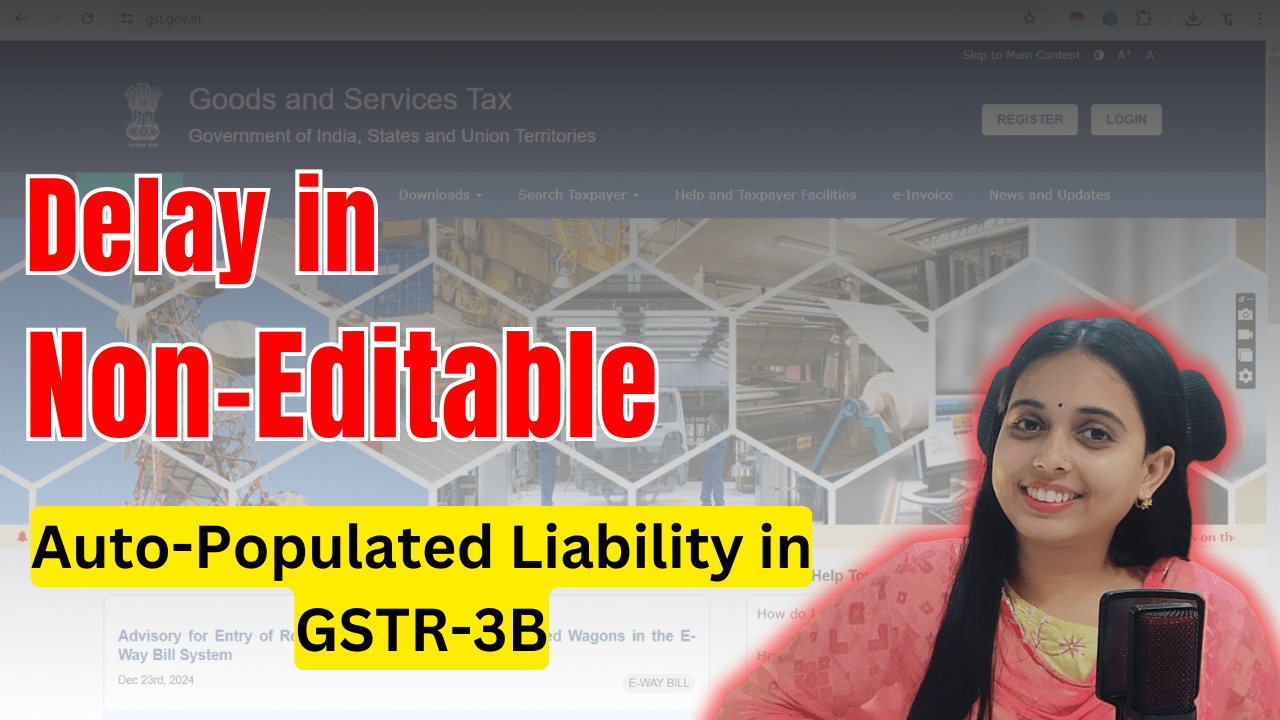Delay in Non-Editable Auto-Populated Liability in GSTR-3B
Introduction
Delay in Non-Editable Auto-Populated Liability in GSTR-3B In an effort to streamline the Goods and Services Tax (GST) filing process and reduce errors, the GST Network (GSTN) had announced a significant change in the way GSTR-3B returns would be filed starting January 2025. The change would have made the auto-populated liability in GSTR-3B non-editable. Delay in Non-Editable Auto-Populated Liability in GSTR-3B However, in response to concerns and requests from the trade, the implementation of this change has been postponed. Let’s explore what this delay means for taxpayers and how they can prepare for the upcoming change.
What Was the Proposed Change?
The core of the proposed change was to lock the auto-populated liability in the GSTR-3B. In simple terms, this means that the tax liability for a particular period (such as output tax liability, input tax credit, etc.) would be automatically populated in the GSTR-3B return, and taxpayers would not be able to make any edits to this auto-populated information.
The goal was to ensure greater accuracy in tax filings and reduce the chances of errors or discrepancies in the reported figures. Delay in Non-Editable Auto-Populated Liability in GSTR-3B The auto-populated data is derived from other returns filed by taxpayers, such as GSTR-1 (outward supply) and GSTR-2A (input tax credit). Locking this data would have streamlined the process and reduced instances of mismatched tax payments or incorrect reporting.
Why Was the Change Delayed?
Despite the intended benefits, the GSTN received several requests and feedback from the trade and industry stakeholders. These requests highlighted concerns over the sudden implementation of this feature, especially since it could impact taxpayers who rely on manual adjustments or those who are not fully comfortable with the auto-populated data.
In response to these concerns, the GSTN decided to defer the implementation of this non-editable auto-populated liability feature. This means that for the time being, taxpayers will still have the flexibility to modify the auto-populated values in their GSTR-3B, just as they have been doing in previous tax periods.
Current Status and Next Steps
While the change will not be enforced from January 2025 as initially planned, it is important to note that the GSTN has confirmed that the restriction will be introduced soon. Delay in Non-Editable Auto-Populated Liability in GSTR-3B Although a specific timeline has not been provided, taxpayers should stay alert for future announcements regarding this important change.
The GSTN encourages taxpayers to begin preparing for the eventual implementation of this feature. Even though the changes are on hold for now, understanding how the auto-populated liabilities will work when the feature is activated will help taxpayers transition smoothly when the time comes.
https://services.gst.gov.in/services/advisoryandreleases/read/578
What Should Taxpayers Do Now?
- Stay Informed: Keep an eye on official updates from GSTN or any advisories regarding the final implementation date for the non-editable auto-populated liabilities in GSTR-3B.
- Review GSTR-3B Process: Taxpayers should familiarize themselves with the current auto-population feature in GSTR-3B, as understanding this process will be crucial when the feature becomes non-editable.
- Verify Auto-Populated Data: As the changes may impact how data is handled, it is essential for taxpayers to verify the accuracy of their auto-populated data before filing. Ensuring that the data in GSTR-1, GSTR-2A, and GSTR-3B is accurate will reduce errors in future filings. Delay in Non-Editable Auto-Populated Liability in GSTR-3B
- Prepare for Automation: With the possibility of auto-populated data becoming non-editable, businesses should start focusing on improving the accuracy of their data inputs and relying more on automation tools for GST return filing.
Conclusion
Delay in Non-Editable Auto-Populated Liability in GSTR-3B The delay in implementing the non-editable auto-populated liability feature in GSTR-3B provides taxpayers with more time to adjust and align their processes with the upcoming change. While the implementation of this feature has been postponed, taxpayers are strongly encouraged to prepare for its introduction to ensure a smooth transition when it is eventually enforced.
By staying informed, reviewing filing processes, and verifying auto-populated data, businesses can avoid the disruptions this change might otherwise cause and ensure compliance with future GST regulations. Stay updated with GSTN advisories to avoid any surprises, and take proactive steps to improve your GST filing system.
For More Information :https://taxgyany.com/

